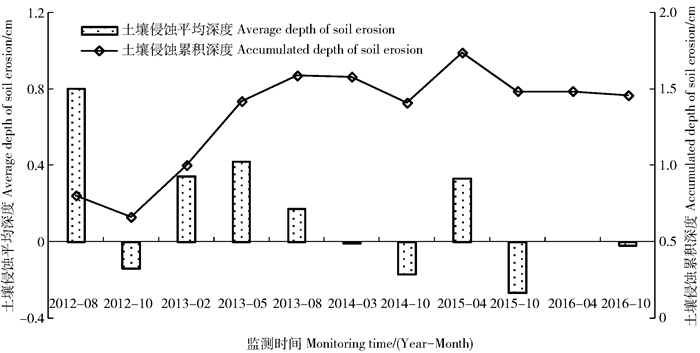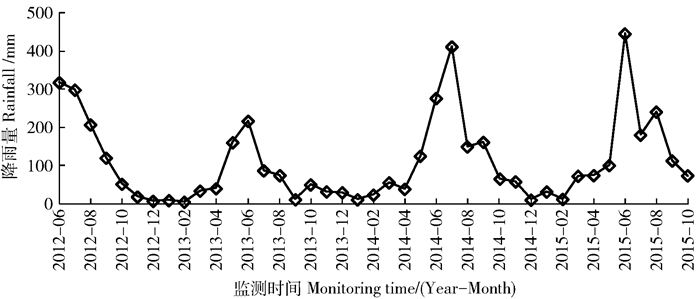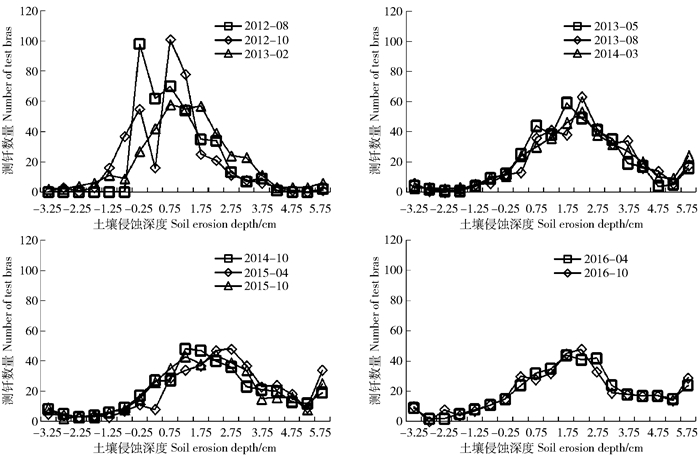2. 中国科学院普定喀斯特生态系统观测研究站, 562100, 贵州普定
-
项目名称
- 国家重大科学研究计划"基于水-岩-土-气-生相互作用的喀斯特地区碳循环模式及调控机理"(2013CB956702);贵州省一流学科建设项目(GNYL[2017]007);贵州百层次人才创新项目(QHKRC-2015-4022);黔科合基金[2017]1018
-
第一作者简介
- 石燕金(1994-), 女, 硕士研究生。主要研究方向:水土保持与荒漠化防治。E-mail:2551889679@qq.com
-
通信作者简介
- 周运超(1964-), 男, 博士, 教授。主要研究方向:森林土壤碳固定及林木营养。E-mail:yc409@163.com
-
文章历史
-
收稿日期:2018-05-08
修回日期:2018-08-08
2. 中国科学院普定喀斯特生态系统观测研究站, 562100, 贵州普定
2. Puding Karst Ecosystem Research Station, Chinese Academy of Sciences, 562100, Puding, Guizhou, China
土壤侵蚀——造成侵蚀源区的土壤量减少、肥力退化等,在下游地区会引起河流淤塞、农田淹没、空气污染等[1],是全世界面临的共同问题[2]。喀斯特地区由于基岩(主要为碳酸盐岩)中酸不溶物含量低,风化速率较慢,成土速率很慢[3]的综述,碳酸盐岩地区的成土速率为6.84~68 t/(km2·a),土壤一旦流失,将很难恢复。土壤的缺失会导致生态系统的抗干扰(干旱等)能力减退,使生态系统变得脆弱。在此背景下,亚热带喀斯特地区极容易产生喀斯特石漠化[4],在中国西南地区,已形成较大面积的喀斯特石漠化,其面积还在逐年增加,导致一系列的环境和社会问题[5];因此,对于喀斯特石漠化地区土壤侵蚀应足够重视。前人通过实测(径流场法[6]、沉积泥沙反演[7]、核素示踪[8]、树木解剖学特征[9])以及模拟(模型模拟[10]、控制性实验[11])等方法,对喀斯特地区的土壤侵蚀模数[12]、侵蚀产生的机理[13]、造成的经济损失[14]、影响因素[15]及治理方法[16]进行了探讨。认为喀斯特土壤侵蚀受地质背景、地形地貌、土壤性质、气候条件、植被状况、人类活动等多种因素影响,侵蚀模数从每年每km2几吨到几干吨不等[3]。皆伐会导致土壤裸露,在外力的作用下极容易形成土壤侵蚀[17]。土壤侵蚀研究有多种方法[18],喀斯特地区(尤其是喀斯特石漠化地区)由于土壤与岩石的交替分布以及地上地下二元三维结构,导致通常情况下降雨无法在坡面上产生连续的地表径流[19],从而侵蚀的土壤不是沿着地表进行长距离的迁移,而是以蠕滑等形式进行短距离渐进式迁移,以及沿岩土界面、落水洞等向地下垂直迁移[20];因此,监测土壤侵蚀极为困难,测钎法能够较好地解决这种问题。鉴于以上事实,笔者拟采用测钎法结合经典土壤侵蚀研究方法——径流场法对喀斯特石漠化地区森林皆伐迹地自然恢复过程的土壤侵蚀开展连续的对比研究,分析2种监测方法的实用性,以期能阐明该条件下土壤侵蚀的状况,找出侵蚀发生的规律和机理。
1 研究区概况贵州省普定县(E 105°27′49″~105°58′51″,N 26°26′36″~26°31′42″),属亚热带季风湿润气候区,年平均气温15.1 ℃,年平均降水1 378.2 mm,主要集中在每年的4—10月,境内碳酸盐岩出露面积占全县总面积的84%,主要为白云岩和石灰岩,地貌为高原浅碟形峰从洼地。赵家田皆伐样地(N 26°16′30″,E 105°46′55″)位于普定县城关镇赵家田村,样地海拔1 440 m,平均坡度为24°,基岩为泥灰岩,土壤为石灰土,分布不连续,平均厚度约为30 cm,平均表层土壤密度为0.98 g/cm3,岩石裸露率为35%,样地皆伐前为地带性近顶级群落(常绿落叶阔叶混交林),林龄约为40年,优势物种为滇鼠刺(Itea yunnanensis Franch)、猴樟(Cinnamomum bodinieri Levl)、崖樱桃(Cerasus scopulorum Koehne Yu et Li)等。样地于2012年5月进行皆伐,砍伐面积为1 000 m2(横坡向25 m×顺坡向40 m),将植被地上部分全部伐除并清除出样地外。
2 材料与方法 2.1 实验设施布置及监测方法于2012年5月完成皆伐,同年6月在样地内以均匀布点法每隔1 m设置测钎(外径18 mm的PVC管)一根并编号,将测钎插入地面一定深度(若点分布在石面上则跳过)后测定1次土壤表面到测钎顶部的距离作为本底值,以后每次监测时测定各测钎地面到测钎顶部的距离,减掉上次的值即为2次测量期间土壤侵蚀深度,正值表示有侵蚀,负值表示有沉积。考虑到样地恢复前期土壤侵蚀可能变化较快而后期可能趋于平缓,因此在前期监测频率较高(每2个月监测1次),而后期逐渐过渡到每6个月监测1次(其中2013年2月到8月为每3个月监测1次),具体监测频率与监测间期情况见图 1,测定使用钢卷尺完成。设置测钎的同时,沿皆伐区域外沿修建面积为780 m2的径流场,设置沉沙池,降雨后监测泥沙量。

|
图 1 监测频率及间期情况 Fig. 1 Monitoring frequency and interval |
通过整理数据,得出各次都有效的测钎385根,通过计算各次监测时所有测钎的侵蚀深度平均值以及侵蚀深度累计值,找出土壤侵蚀的变化规律;通过绘制各次监测时测钎侵蚀深度分布频次图,可以进一步了解土壤侵蚀深度变化的原因,并分析其影响因素。为了便于与径流场法得出的结果比较,兼顾该区域的岩石裸露率较大且岩石的侵蚀在监测期内可以忽略的实际情况,将测钎法测得的土壤侵蚀深度转换为土壤侵蚀量,计算公式为
| $ A = h\left( {S\left( {1 - R} \right)} \right)D。$ | (1) |
式中:A为土壤侵蚀量,g;h为土壤侵蚀深度,m;S为监测面积,m2,S=780 m2;R为岩石裸露率,%,R=35%;D为土壤密度,g/m3,实测值D=0.98 g/m3。
3 结果与分析 3.1 测钎法土壤侵蚀深度随时间变化由图 2可知,总体而言,喀斯特石漠化皆伐迹地自然恢复过程中,土壤发生侵蚀,在4.5年左右时间内,土壤累积侵蚀深度为1.46 cm,在此过程中,侵蚀深度有波动(有时侵蚀有时沉积),并在3.5年左右趋于平稳。其中侵蚀深度的波动,可能是喀斯特土壤侵蚀的特性和测钎法监测的特点的共同作用,2次监测期间泥沙输出大于输入就会导致总体平均值表现为侵蚀,反之,则会表现为沉积。

|
图 2 测钎法土壤侵蚀深度随时间变化 Fig. 2 Variation of soil erosion depth with time by drilling method |
从测钎设置到第1次监测之间的2个月以及2012年10月到2013年8月和2014年10月到2015年4月这些时间段均表现为侵蚀,第1阶段侵蚀深度的增加可能是由于降雨对裸露土壤表面的冲击导致土壤侵蚀严重(贵州按侵蚀营力划分属于水力侵蚀区[21],径流场监测也在此期间收集到泥沙),而之后的2次侵蚀深度增加较大却有可能是由于土壤有机质含量较高,具有较好的团粒结构,在较为干旱(图 3)的时期团粒间黏力减小而容易受重力作用滚动,同时林下的草本层数量减少(凋萎季)和凋落物较少而无法阻拦土壤滚动,出现侵蚀;而2012年8月到10月、2014年3月到10月和2015年4月到10月均表现为有沉积现象,主要是由于土壤的渐进式迁移正好到达测钎所在的位置,加上林下草本植物(生长季)的阻拦作用;在2015年10月之后,由于植被的恢复、凋落物的增加等,土壤的迁移性降低,趋于稳定。

|
2015年10月后没有可用的降雨数据。No rainfall data available after October 2015 图 3 监测区2012年6月至2015年10月逐月降雨量 Fig. 3 Monthly rainfall in the monitoring area from June 2012 to October 2015 |
由图 4可知,前4次测定的结果有较为明显的右移(侵蚀深度大的测钎数量增加)现象,但其中2012年10月测定时出现了侵蚀深度0.25~0.75 cm之间的测钎数量急剧减少,分别向侵蚀增加和沉积2个方向移动的现象,这就是导致该次监测总体出现沉积的原因。从2013年5月监测之后,各次监测结果之间很难从图上(图 4)看出明显的差异,只有2014年10月监测时介于1.75~2.75 cm之间的测钎数量有较明显的减少,是导致该次监测总体平均值出现沉积现象的原因,以及2015年4月监测时介于0.25~0.75 cm之间的测钎数量有较为明显的减少,而>2.75 cm的测钎数量均有不同程度的增加,是导致该次监测总体平均侵蚀深度增加的原因。总体而言,前期侵蚀深度的分布变化较大,而后期变化较小(除2015年4月监测以外),这主要是由于随着植被的恢复,降雨对土壤侵蚀的作用逐渐减弱的原因。偶尔的不规律波动可能是由于部分测钎受偶然因素(如动物觅食等)影响导致土壤的迁移所致。

|
图例代表监测时间(年-月)。The legend represents the monitoring time (Year-Month) 图 4 各次监测时测钎土壤侵蚀深度分布频次图 Fig. 4 Frequency distribution of soil erosion depth of the test bras at each monitoring |
在监测过程中,径流场仅于2012年7月13日降雨量为67.6 mm,降雨强度达到42.4 mm/h时收集到1次泥沙,质量为2.75 kg,折算(按4.5年,780 m2计)为侵蚀模数为0.78 t/(km2·a),与彭韬等[22]在相近地区的研究结果相近。测钎法测得的4年半的土壤累积侵蚀深度1.46 cm,折算得出的侵蚀模数约为2 066.7 t/(km2·a),2种方法的结果存在巨大差异,而在土壤裸露的条件下,径流场法的结果显得“不合常理”的小。分析认为:喀斯特石漠化地区土石交替分布的地表状况对泥沙产生机械阻拦作用导致泥沙不能长距离迁移进入径流池,也有部分泥沙随水沿土石界面向地下迁移[20],导致以上的结果。另外,径流场法监测的是土壤经过沉砂池断面的通量值,而测钎法所测定的是特定点位的土壤输入与输出差,两者具有不同的监测侧重点和性质,监测结果并不具有普遍的可比性。测钎法由于监测的点较多、能够同时测到侵蚀和沉积的情况,能够降低地表土石交替结构和土壤垂向迁移的影响,具有较好的代表性。
4 结论1) 测钎法监测显示,皆伐自然恢复过程中土壤总体呈侵蚀的趋势,4.5年内累积侵蚀深度为1.46 cm,但在恢复前期存在较大波动,在3.5年后逐渐趋于稳定。
2) 径流场法仅在皆伐后2个月内一次降雨强度约为42.4 mm/h的降雨条件下产生泥沙,侵蚀模数为0.78 t/(km2·a)。
3) 测钎法与径流场法测得的土壤侵蚀量相差很大,2种方法监测的侧重点和性质有较大差异,加上喀斯特土壤侵蚀的短距离渐进式迁移和垂向迁移的特点,导致二者的监测结果不具有普遍的可比性,而测钎法具有更好的代表性。
| [1] |
李海燕. 土壤侵蚀危害及其防治措施研究现状[J].
宁夏农林科技, 2011, 52(1): 71.
LI Haiyan. Research status of soil erosion hazards and its control measures[J]. Ningxia Agricultural and Forestry Technology, 2011, 52(1): 71. DOI: 10.3969/j.issn.1002-204X.2011.01.033. |
| [2] |
孙承恩. 世界的土壤侵蚀与水土保持[J].
中国水土保持, 1982(5): 27.
SUN Chengen. Soil erosion and soil and water conservation in the world[J]. Soil and Water Conservation in China, 1982(5): 27. |
| [3] |
张信宝, 王世杰, 孟天友, 等. 农耕驱动西南喀斯特地区坡地石质化的机制[J].
地球与环境, 2010, 38(2): 123.
ZHANG Xinbao, WANG Shijie, MENG Tianyou, et al. Agricultural driving mechanism of steep slope in Karst area of Southwest China[J]. Earth and Earth Environment, 2010, 38(2): 123. |
| [4] |
王世杰. 喀斯特石漠化概念演绎及其科学内涵的探讨[J].
中国岩溶, 2002, 21(2): 101.
WANG Shijie. Discussion on the conceptual deduction of Karst rocky desertification and its scientific Connotation[J]. China Karst, 2002, 21(2): 101. DOI: 10.3969/j.issn.1001-4810.2002.02.006. |
| [5] |
王世杰. 喀斯特石漠化:中国西南最严重的生态地质环境问题[J].
矿物岩石地球化学通报, 2003, 22(2): 120.
WANG Shijie. Karst rocky desertification:the most serious ecological geological environment problem in Southwest China[J]. Bulletin of Mineralogy, Petrology and Geochemistry, 2003, 22(2): 120. DOI: 10.3969/j.issn.1007-2802.2003.02.007. |
| [6] |
高儒学, 高华端, 宋江平, 等. 坡长对贵州喀斯特区黄壤坡耕地土壤侵蚀的影响[J].
水土保持研究, 2018(2): 53.
GAO Ruxue, GAO Huaduan, SONG Jiangping, et al. Effect of slope length on soil erosion of yellow soil slope in Guizhou karst area[J]. Research of Soil and Water Conservation, 2018(2): 53. |
| [7] |
白晓永, 张信宝, 王世杰, 等.基于峰丛洼地沉积物反演喀斯特地区的土壤侵蚀过程[C]//全国第四纪学术大会, 2014.
BAI Xiaoyong, ZHANG Xinbao, WANG Shijie, et al. Inversion of soil erosion processes in Karst area based on sediments in peak clusters[C]//National Quaternary Academic Conference, 2014. |
| [8] |
张信宝, 白晓永, 刘秀明. 洼地沉积的137Cs法断代测定森林砍伐后的喀斯特小流域土壤流失量[J].
中国科学:地球科学, 2011(2): 265.
ZHANG Xinbao, BAI Xiaoyong, LIU Xiuming. Application of a 137Cs fingerprinting technique for interpreting responses of sediment deposition of a Karst depression to deforestration in the Guizhou Plateau[J]. China Science:Earth Science, 2011(2): 265. |
| [9] |
罗美, 周运超, 王可可. 喀斯特树轮记录的土壤侵蚀历史研究[J].
Journal of Resources and Ecology资源与生态学报(英文版), 2015, 6(4): 257.
LUO Mei, ZHOU Yunchao, WANG Keke. History of soil erosion records recorded by Karst tree rings[J]. Journal of Resources and Ecology, 2015, 6(4): 257. |
| [10] |
冯腾.喀斯特峰丛洼地小流域土壤侵蚀特征及地表流失模拟研究[D].中国科学院大学, 2015: 54.
FENG Teng.Soil erosion characteristics and simulation of land surface drainage in Karst peak clusters in Karst peak cluster[D].University of Chinese Academy of Sciences, 2015: 54. http://www.wanfangdata.com.cn/details/detail.do?_type=degree&id=Y2851344 |
| [11] |
蔡雄飞, 王济, 雷丽, 等. 不同雨强对我国西南喀斯特山区土壤侵蚀影响的模拟研究[J].
水土保持学报, 2009, 23(6): 5.
CAI Xiongfei, WANG Ji, LEI Li, et al. Simulation study on effects of different rainfall intensity on soil erosion in Karst mountainous areas in Southwest China[J]. Journal of Soil and Water Conservation, 2009, 23(6): 5. DOI: 10.3321/j.issn:1009-2242.2009.06.002. |
| [12] |
杨琴, 周忠发, 熊康宁.基于RUSLE与GIS的喀斯特地区土壤侵蚀定量评价: 以贵州省毕节市鸭池示范区为例[C]//现代地理科学与贵州社会经济, 2009: 220.
YANG Qin, ZHOU Zhongfa, XIONG Kangning. Quantitative evaluation of soil erosion in Karst area based on RUSLE and GIS: A case study of Yachi in Bijie city, Guizhou province example of Fan district[C]//Modern Geographical Science and Guizhou Social Economy, 2009: 220. |
| [13] |
孙泉忠, 高华端, 刘瑞禄, 等. 黔中喀斯特地区土力学特性对土壤侵蚀的影响[J].
水土保持学报, 2010, 24(6): 38.
SUN Quanzhong, GAO Huaduan, LIU Ruilu, et al. Effects of soil mechanics properties on soil erosion in the Karst area of central Guizhou province[J]. Journal of Soil and Water Conservation, 2010, 24(6): 38. |
| [14] |
杨洁, 龙明忠. 喀斯特峡谷区土壤侵蚀的经济损失初步估值与分析:以花江示范区为例[J].
贵州师范大学学报(自然科学版), 2005, 23(4): 13.
YANG Jie, LONG Mingzhong. Preliminary estimation and analysis of economic loss caused by soil erosion in Karst Gorge Area:the demonstration area of Huajiang as an example[J]. Journal of Guizhou Normal University(Natural Science), 2005, 23(4): 13. DOI: 10.3969/j.issn.1004-5570.2005.04.004. |
| [15] |
黄玲玲, 陈喜, 张志才. 西南岩溶地区小流域坡地土壤侵蚀影响因素分析[J].
水电能源科学, 2013(8): 132.
HUANG Lingling, CHEN Xi, ZHANG Zhicai. Analysis of influencing factors of soil erosion on slope land in small watershed in Southwestern Karst Region[J]. International Journal Hydroelectric Energy, 2013(8): 132. |
| [16] |
龙明忠.喀斯特峡谷区生态治理的水土保持效应与土壤侵蚀模型[D].贵州师范大学, 2006: 15.
LONG Mingzhong. Water and soil conservation effect and soil erosion model of ecological restoration in Karst canyon area[D]. Guizhou Normal University, 2006: 15. http://cdmd.cnki.com.cn/Article/CDMD-10663-2006100284.htm |
| [17] |
满秀玲, 赵雨森, 屈宜春. 采伐与造林对林地土壤的影响[J].
林业勘查设计, 1998(2): 42.
MAN Xiuling, ZHAO Yusen, Qu Yichun. Influence of cutting and afforestation on forest soil[J]. Forest Prospecting Design, 1998(2): 42. |
| [18] |
唐强, 鲍玉海, 贺秀斌, 等. 土壤侵蚀监测新方法和新技术[J].
中国水土保持科学, 2011, 9(2): 11.
TANG Qiang, BAO Yuhai, HE Xiubin, et al. New methods and technologies for soil erosion monitoring[J]. Science of Soil and Water Conservation, 2011, 9(2): 11. DOI: 10.3969/j.issn.1672-3007.2011.02.003. |
| [19] |
朱晓锋, 陈洪松, 付智勇, 等. 喀斯特灌丛坡地土壤-表层岩溶带产流及氮素流失特征[J].
应用生态学报, 2017, 28(7): 2197.
ZHU Xiaofeng, CHEN Hongsong, FU Zhiyong, et al. Characteristics of runoff and nitrogen loss in soil-surface karst zones in karst scrubland slopes[J]. Chinese Journal of Applied Ecology, 2017, 28(7): 2197. |
| [20] |
张信宝, 王世杰, 贺秀斌, 等. 碳酸盐岩风化壳中的土壤蠕滑与岩溶坡地的土壤地下漏失[J].
地球与环境, 2007(3): 202.
ZHANG Xinbao, WANG Shijie, HE Xiubin, et al. Crop creep in carbonate weathered crusts and soil underflow in karst slopes[J]. Earth and Environment, 2007(3): 202. |
| [21] |
唐克丽.
中国水土保持[M]. 北京: 科学出版社, 2004: 218.
TANG Keli. Soil and water conservation in China[M]. Beijing: Science Press, 2004: 218. |
| [22] |
彭韬, 杨涛, 王世杰, 等. 喀斯特坡地土壤流失监测结果简报[J].
地球与环境, 2009, 37(2): 126.
PENG Tao, YANG Tao, WANG Shijie, et al. A brief report on monitoring results of soil loss in Karst slopes[J]. Earth and Environmenbt, 2009, 37(2): 126. |
 2018, Vol. 16
2018, Vol. 16 
